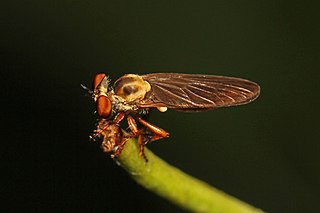
The big-belly seahorse or pot-bellied seahorse is one of the largest seahorse species in the world, with a length of up to 35 cm (14 in), and is the largest in Australia. Seahorses are members of the family Syngnathidae, and are teleost fishes. They are found in southeast Australia and New Zealand, and are listed on Appendix II of CITES. They are the only species of seahorse found in New Zealand, with a habitat range spanning from the Three Kings Island in the north all the way to the Snares Island in the south.

The green damselfish, also known as the Hawaiian sergeant major, is a non-migratory fish of the family Pomacentridae. It occurs in the Pacific Ocean in the vicinity of the Hawaiian Islands, Midway Island and Johnston Atoll. It can grow to a maximum total length of 30 centimetres (12 in).

Camponotus atriceps, previously referred as C. abdominalis, is a species of carpenter ant, endemic to the Americas.
Stenarctia abdominalis is a moth of the subfamily Arctiinae first described by Rothschild in 1910. It is found in Angola, Cameroon, Kenya, Sierra Leone and Uganda.

Prosoplus is a genus of longhorn beetles of the subfamily Lamiinae, containing the following species:
Prosoplus atlanticus is a species of beetle in the family Cerambycidae. It was described by Stephan von Breuning in 1938.
Prosoplus rugulosus is a species of beetle in the family Cerambycidae. It was described by Stephan von Breuning in 1938.
Prosoplus paganoides is a species of beetle in the family Cerambycidae. It was described by Stephan von Breuning in 1940. It is known from Papua New Guinea and Moluccas.
Prosoplus imitans is a species of beetle in the family Cerambycidae. It was described by Stephan von Breuning in 1961.

Rhytiphora bankii is a species of beetle in the family Cerambycidae. It was first described by Johan Christian Fabricius in 1775, under the genus Lamia. It is known from Australia, the Philippines, Borneo, Java, Micronesia, New Guinea, Hawaii, Moluccas, Sumatra, Vietnam, and has been introduced into Japan. The Australian species of Prosoplus were synonymised with Rhytiphora in 2013.
Prosoplus costatus is a species of beetle in the family Cerambycidae. It was described by Karl-Ernst Hüdepohl in 1996. It is known from Borneo and Malaysia.
Prosoplus dentatus is a species of beetle in the family Cerambycidae. It was described by Guillaume-Antoine Olivier in 1792. It is known from Mauritius, Seychelles, Réunion, and Madagascar. It contains the varietas Prosoplus dentatus var. ochreomaculatus.
Prosoplus kambangensis is a species of beetle in the family Cerambycidae. It was described by Stephan von Breuning and de Jong in 1941.
Prosoplus lividus is a species of beetle in the family Cerambycidae. It was described by Masaki Matsushita in 1935.
Prosoplus sinuatofasciatus is a species of beetle in the family Cerambycidae. It was described by Blanchard in 1855.
Tarache abdominalis is a species of bird dropping moth in the family Noctuidae. It is found in North America.

Stichopogon abdominalis is a species of robber fly in the family Asilidae.

Holcocephala abdominalis is a species of robber fly in the family Asilidae.

Tipula abdominalis, the giant crane fly, is a species of large crane flies in the family Tipulidae.
Thyreus abdominalis is a species of bee belonging to the genus Thyreus, the members of which are often referred to as cuckoo bees. Like all bees in this genus, it is kleptoparasitic. It is found throughout southern and eastern Asia.







